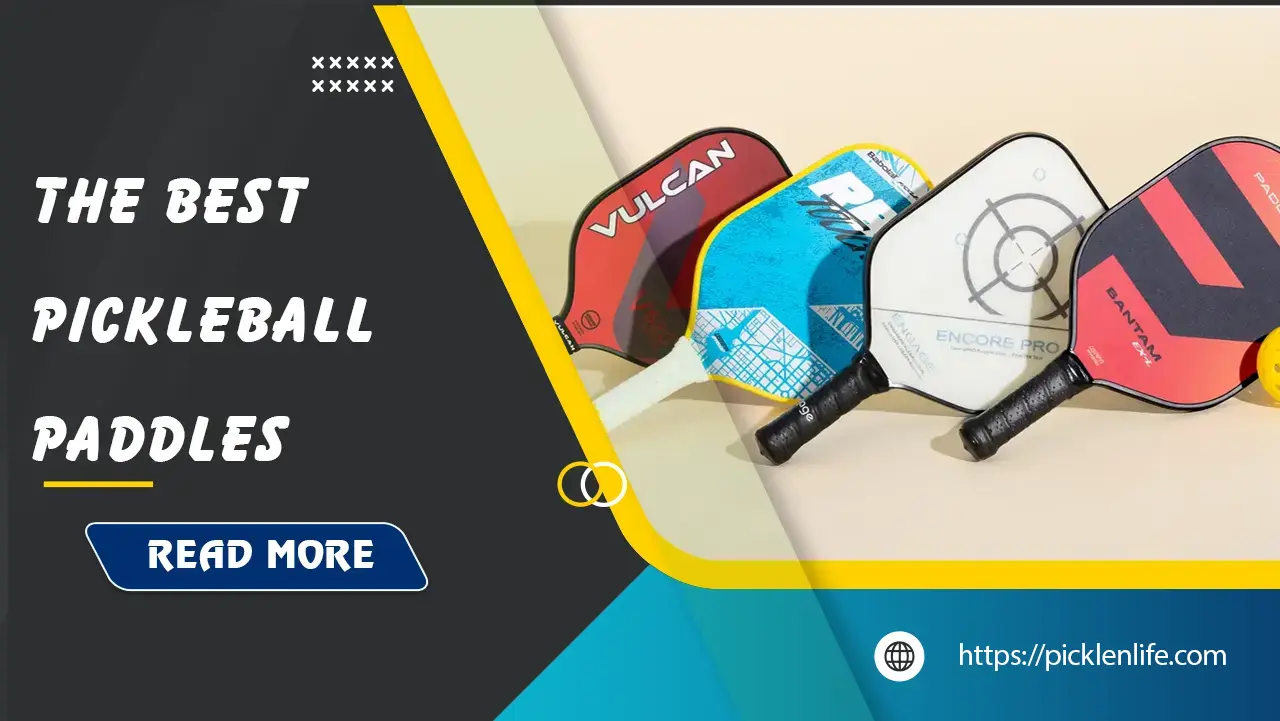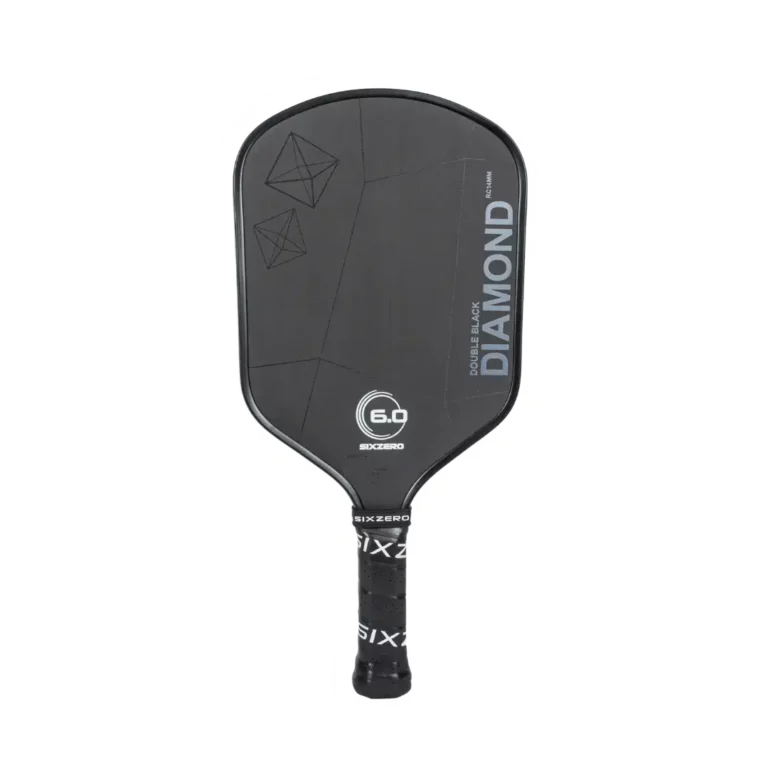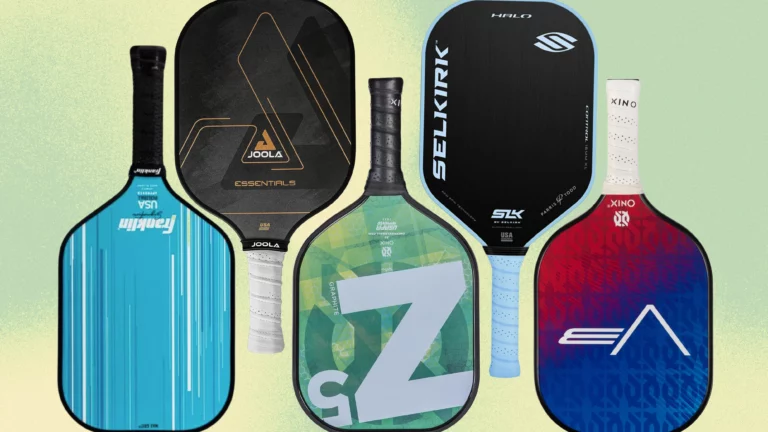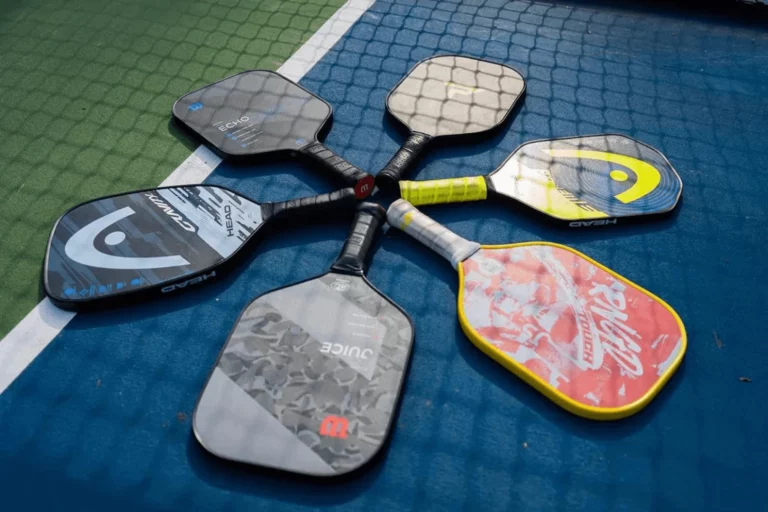Pickleball, the fast-paced court game that has captured the hearts of many, continues to grow, garnering a diverse player base, from beginners to seasoned pros. As you step onto the court, the right paddle can make all the difference, elevating your game and enhancing your overall experience. With so many options available, choosing the perfect paddle might feel overwhelming. Do you prioritize power, control, or affordability? The paddles we will explore are carefully curated to cater to every style of play and budget, ensuring that everyone can find the right match for their unique game.
In this extensive guide, we’ll delve into the best pickleball paddles for 2025. We’ll examine top options based on various player levels and needs. From the Six Zero Double Black Diamond Control, which stands out for its all-around excellence, to budget-friendly options like the Vatic Pro PRISM Flash, each paddle offers a distinctive set of features and benefits. Whether you’re new to the sport or aiming to refine your skills, our list will provide insights to help you make an informed decision. With a blend of user reviews, expert opinions, and detailed specifications, this comprehensive overview will be your ultimate guide to choosing the perfect pickleball paddle.

Top Best Pickleball Paddles 2025
As the sport continues to evolve, so too do the technologies and designs behind pickleball paddles. For 2025, several paddles have emerged as the cream of the crop, showcasing a remarkable blend of control, power, and versatility.
- Six Zero Double Black Diamond Control – Best Overall
- Vatic Pro PRISM Flash – Budget-Friendly.
- Onix Z5 – Best for Beginners
- Selkirk Amped Pro Air – Best for Intermediate Players
- CRBN-3X Power Series – Best for Advanced Players
- Gearbox CX11Q Power – Best for Power
- Gearbox CX14E Ultimate – Best for Spin
- JOOLA Simone Jardim Hyperion CFS 16mm – Best for Control
- Paddletek Tempest Wave Pro – Best for Women
- SLK Omega Max – Best Edgeless
- Paddletek Tempest Wave Pro V3 – Biggest Sweet Spot
- SLK Neo 2.0 – Best Set
Let’s take a closer look at each of these paddles to help you determine which might suit your style of play best.
1. Best Overall: Six Zero Double Black Diamond Control
The Six Zero Double Black Diamond Control paddle is widely recognized as the best overall option for pickleball players looking to enhance their game. It’s as if the perfect marriage of precision and power has been achieved in this paddle.

- Material: Premium Japanese Toray nano-engineered 700K carbon textured surface
- Weight: 7.5 to 8.5 ounces
- Core Thickness: 16mm
- Performance Rating: Excellent balance between control and power for versatile gameplay.
- Price Range: Higher-end, from $180 upwards.
Who It Suits
This paddle is suitable for players of all skill levels, from beginners looking to develop their skills to advanced players aiming to fine-tune their game. Its blend of features provides consistency and reliability on the court, appealing to anyone who wants the best from their equipment.
Features
What’s remarkable about the Six Zero Double Black Diamond Control is its innovative surface technology. It aids players in maintaining precise ball control while also delivering the necessary punch for those aggressive shots. This balance is critical for players who desire both finesse and strength.
Design and Feel
With a focus on ergonomics, the paddle’s handle is designed for comfort. Players often describe it as feeling secure and natural in hand, reducing fatigue even during lengthy matches. The overall lightweight construction allows for quick maneuverability, essential for fast-paced play.
Performance
When it comes to performance, feedback from users has been overwhelmingly positive. Many report a significant improvement in their shot accuracy after switching to this paddle. Whether you’re executing a delicate drop shot or a powerful serve, the feedback is constant and precise.
Value for Money
Despite its high-performance features, this paddle is competitively priced considering the quality it offers, making it accessible for serious players. With its extended warranty and durability, buyers can feel confident in their investment.
2. Budget-Friendly: Vatic Pro Prism Flash
On the hunt for a quality paddle without breaking the bank? The Vatic Pro PRISM Flash delivers exceptional value, standing out as the best budget-friendly option for 2025.

- Material: Optimized C7 polymers with high-grade performance honeycomb
- Weight: Ranges from 7.7 to 8.2 ounces
- Core Thickness: Available in 16mm or 14mm options
- Performance Rating: Strong spin and control at an affordable price of under $100
Who It Suits
This paddle is perfect for beginners and intermediate players seeking a reliable, high-performing paddle without the hefty price tag. If you want an affordable option that still boasts performance, the Vatic Pro PRISM Flash is an excellent choice.
Features
Weighing in at approximately 7.7–8.2 oz, this paddle is lightweight, allowing for easy handling and maneuverability. Constructed from raw Toray T700 carbon fiber, it not only signals durability but also enhances spin potential, making it a versatile option for various playing styles.
Design and Feel
With dimensions of around 16 ⅓” in length and 7 ⅔” in width, the paddle feels well-balanced in hand. Players have noted the comfortable grip, enabling longer play sessions without discomfort.
Performance
Performance-wise, the Vatic Pro PRISM Flash scores exceptionally well. Rated 10/10 for control and 9/10 for spin, it excels during tactical shots like dinks and drops. Players appreciate how it allows for strategic plays during matches, enhancing their overall skill set.
Value for Money
Priced under $100, the Vatic Pro PRISM Flash delivers high performance without a hefty investment. This makes it an appealing option for those new to pickleball or players on a budget aiming for quality gear.
3. Best For Beginner: Onix Z5
The Onix Z5 is often celebrated as the best paddle for beginners, offering an excellent combination of power and control to help new players grow their skills.

- Material: Graphite face with a nomex core
- Weight: Approximately 7.8 ounces
- Core Thickness: Standard at 16mm
- Performance Rating: Great balance of power and control to foster learning, typically priced around $90.
Who It Suits
This paddle is ideal for novice players who are just starting out in pickleball but offer a degree of advanced performance for those who are becoming more seasoned with experience.
Features
The Onix Z5 features a graphite face with a Nomex core, providing a perfect blend of power and precision. Its lightweight nature (weighing approximately 7.5-8.2 oz) makes it a joy to use for extended periods while providing substantial control.
Design and Feel
Mimicking the feel of a tennis handle, this paddle’s shape enhances gripping comfort. With a circumference of about 4 ¼ inches, it offers a secure hold for various hand sizes, making it suitable for many players.
Performance
One of the standout features of the Z5 is its generous sweet spot, which makes it easier for beginners to make contact with the ball, fostering confidence during matches. Known for balancing power and speed, it can handle everything from soft placed shots to powerful serves with ease.
Value for Money
At around $89.99, the Onix Z5 remains an economical choice that meets the criteria needed for serious gameplay. Even while being budget-friendly, it boasts quality materials and performance that any new player will appreciate..
4. Best For Intermediate Player: Selkirk Amped Pro Air
The Selkirk Amped Pro Air is recognized as the top choice for intermediate players wanting to take their game to the next level.

- Material: Fiberglass and carbon fiber combination
- Weight: Mid-weight for versatility
- Core Thickness: Large sweet spot for a balance of power and finesse
- Price Range: Approximately $180.
Who It Suits
This paddle is tailored for players who have mastered the basics and are ready to introduce more strategies into their game.
Features
Designed with an elongated shape, this paddle enhances the player’s reach, enabling more powerful shots. Its construction combines fiberglass and carbon fiber, elevating surface responsiveness while reducing unwanted vibration.
Design and Feel
The Selkirk Amped Pro Air has a thickness of 13 mm, which is beneficial for powerful strikes while ensuring comfort during two-handed backhand strokes. The 4.25-inch grip allows for fluid handling and maximum control.
Performance
This paddle shines in both power and control, giving players the ability to generate spin and deliver powerful shots. Users appreciate its reliability during competitive play, aiding their growth and enhancing their personal style of play.
Value for Money
Priced at $145, the Selkirk Amped Pro Air stands out as a worthwhile investment for those looking to boost their skills with a quality paddle. Thanks to its approval by the USA Pickleball Association, players can use it in official tournaments as well.
5. Best For Advanced Player: CRBN-3X Power Series
Designed for advanced players focusing on both power and spin, the CRBN-3X Power Series caters to those who push their limits on the court.

- Material: High-quality construction
- Performance Features: Textured surface to improve spin potential
- Price: Positioned in the upper-end price range of $230 or more.
Who It Suits
Perfect for competitive players seeking to maximize their on-court performance, this paddle caters to serious pickleball enthusiasts.
Features
This paddle’s textured carbon fiber surface provides excellent grip, enabling high spin potential during gameplay. This design often translates into dominating serves and powerful overhead shots.
Design and Feel
Weighing between 7.8-8.1 oz, it is sturdy yet manageable, allowing for control during fast exchanges or quick movements. The paddle is ergonomically designed, keeping comfort central during long matches.
Performance
Players have highlighted the CRBN-3X’s generous sweet spot, aiding accuracy even when shots aren’t perfectly executed. It mitigates vibration, enhancing comfort during powerful shots, allowing for a seamless play experience.
Value for Money
At approximately $239.99, it is on the higher end of the price spectrum yet remains affordable for serious players. The investment pays dividends through its state-of-the-art design and impressive performance characteristics.
6. Best For Power: Gearbox CX11Q Power
When it comes to power, the Gearbox CX11Q Power excels, making it a go-to choice for aggressive players eager to dominate the court.

Who It Suits
Ideal for strong players wanting to enhance their shot-making, this paddle is designed for those who love to hit hard and fast.
Features
This paddle features an elongated design providing a larger hitting surface. It is crafted from advanced carbon fiber, delivering enhanced durability along with explosive power.
Design and Feel
The Gearbox CX11Q Power’s shape allows for maximum surface area, which helps players make impactful shots. Its lightweight design (about 7.6 to 8.1 oz) allows for more swift movements on the court.
Performance
Balancing power with control, this paddle allows players to retain accuracy even when delivering strong shots. Users appreciate the feedback received upon ball contact, contributing further to their overall gameplay.
Value for Money
Recognized as a premium paddle, it represents a solid investment for players focused on honing their powerful stroke. Pricing typically hovers around $199, which is reasonable for the features and advantages offered.
7. Best For Spin: Gearbox CX14E Ultimate
For players wishing to turn the tide of a game with finesse and spin, the Gearbox CX14E Ultimate emerges as a finely tuned option.

Who It Suits
This paddle is aimed at players who thrive on strategy and placement, focusing on adding spins to their shots as a weapon.
Features
The paddle is designed for maximizing spin potential, enabling players to easily add topspin or backspin to their shots. This allows for strategic advantages during play.
Design and Feel
With a 14 mm thick core, it balances strength and control, promoting a responsive and controlled gameplay experience. Its wider face helps in achieving precise spin shots, allowing for creative playing styles.
Performance
Players have noted its ability to adapt to varying shot types, making it a versatile choice. Its lightweight structure ensures that even with spins, quick movements remain unhindered.
Value for Money
Priced similarly to its counterparts at around $199, it captures essential characteristics for any player looking to amplify their spin technique without compromising quality.
8. Best For Control: Joola Simone Jardim Hyperion CFS 16mm
Recognized for its exceptional control, the JOOLA Simone Jardim Hyperion CFS 16mm facilitates precision in complex gameplay.

Who It Suits
Designed for intermediate and advanced players, this paddle is a perfect match for those who prioritize accuracy and strategy in their gaming approach.
Features
With a 16mm core thickness, this paddle supports energy absorption upon impact, enhancing control, especially during softer shots like dinks. It features a unique carbon friction surface that promotes spin.
Design and Feel
The ergonomic design ensures long-term comfort during extended usage, allowing players to maintain precision shots without fatigue.
Performance
With a generous sweet spot, it empowers players to hit the ball efficiently and effectively, transforming gameplay into a strategic endeavor and enhancing overall gameplay performance.
Value for Money
At a price point of around $179, this paddle reflects its premium design targeted at precision-focused players, justifying its cost through superior control and performance.
9. Best For Women: Paddletek Tempest Wave Pro
The Paddletek Tempest Wave Pro has emerged as a top choice for female players thanks to its thoughtfully designed features catering specifically to women’s playing styles.

Who It Suits
Perfect for recreational and competitive female players, this paddle supports comfort and performance designed for a woman’s hand size and playing style.
Features
This paddle boasts a lightweight construction, dual-layer technology allowing for a balance of power and control, optimized grip size, and inviting aesthetics.
Design and Feel
Exclusive design considerations enhance comfort during extended matches, while the visuals provide a vibrant flair, making it a stylish choice on the court.
Performance
Players appreciate the unique blend of performance features, allowing for effective shots and overall satisfaction during gameplay, enhancing their experience.
Value for Money
Priced at approximately $119, it caters to women looking for performance and comfort in their equipment, making it a worthwhile investment.
10. Best Edgeless: SLK Omega Max
The SLK Omega Max offers durability and innovative design, making it an excellent choice for players who prefer an edgeless paddle.

Who It Suits
Designed for both novice and experienced players alike, this paddle delivers impressive performance without the weight of traditional designs.
Features
The edgeless design results in a larger sweet spot valid for off-center hits while maintaining solid control. It’s constructed from a blend of carbon fiber and fiberglass, making it a suitable long-term investment.
Design and Feel
Weighing between 7.6 to 8.1 oz, the paddle boasts an octagonal handle improving grip comfort during play. Players feel confidence in their shots due to its forgiving design.
Performance
Emphasizing both power and precision, the SLK Omega Max is a competitive option for players who want to explore finesse in their play. Its larger sweet spot adds to its forgiving nature.
Value for Money
Retailing for about $128.98, it stays competitive among paddles offering similar advantages, presenting a solid choice for serious players.
11. Biggest Sweet Spot: Paddletek Tempest Wave Pro V3
The Paddletek Tempest Wave Pro V3 is recognized for its larger sweet spot, turning it into an ideal choice for players focusing on consistency.

Who It Suits
Suitable for players of varying skill levels, this paddle works particularly well for those who want to increase their accuracy and reduce miss-hits.
Features
Built with composite materials that enhance performance, its sweet spot is designed to assist players in achieving effective shots, helping them improve their game.
Design and Feel
Known for its lightweight design, it allows rapid response during gameplay. The paddle also maintains control without compromising the power required for decisive hits.
Performance
Players benefit from its forgiving nature, while maintaining good performance features that enhance playstyle, especially during intense rallies or swift exchanges.
Value for Money
Approximately priced at $139.95, this paddle effectively balances quality and affordability, making it an appealing choice for dedicated players.
12. Best Set: SLK Neo 2.0
Finally, the SLK Neo 2.0 is recognized as one of the best pickleball paddle sets, suitable for players looking for reliability and consistency.

Key Features of the SLK Neo 2.0:
- Balance of Power and Control: Harmonizes strength and finesse for various playing styles.
- Durable Construction: Built to withstand frequent play.
- Lightweight Design: Weighing between 7.5 to 8.5 ounces.
- Comfortable Grip: Designed to enhance play without fatigue.
- Large Sweet Spot: Eases shot-making, even for developing players.
Customer Testimonials and Experiences
As we transition toward recommendations, let’s draw on customer reviews and comparisons of the featured paddles to understand their suitability across various play styles. Review sources provide rich insights, enabling potential buyers to make informed decisions, reflecting a shared sentiment among pickleball enthusiasts.

There’s a common thread woven through customer testimonials that illuminate the strengths and weaknesses of popular paddles.
- Six Zero Double Black Diamond Control: Players rave about its balance of power and precision, with many noting how it supports various play styles seamlessly, from dinks to drives.
- Vatic Pro Prism Flash: Newcomers appreciate its affordability and responsiveness, particularly how the grip feels almost a natural extension of their arm, which enhances learning curves.
- Onix Z5: Feedback from beginners consistently highlights its forgiving nature, especially during moments of doubt when executing serves and volleys.
- Selkirk Amped Pro Air: Intermediate players routinely underscore the paddle’s broad sweet spot, calling it a great ally in developing their skills without fear of numerous mishits.
- CRBN-3X Power Series: Advanced players pull no punches, emphasizing how effective the spin on this paddle translates into competitive matches, allowing them to keep rivals on their toes.
Overall, customer experiences become powerful indicators of a product’s practical performance on the court.
Trends in Pickleball Paddle Technology
In the rapidly evolving world of pickleball, paddle technology continues to push the boundaries of performance and comfort. Recent trends have led to innovations that not only enhance gameplay but also address the specific needs of players. Just as a seasoned chef refines their techniques with modern tools, pickleball players are now benefiting from enhancements that elevate their game to new heights.

One significant trend is smart technology integration in paddles, allowing players to track performance metrics like shot speed, accuracy, and paddle impact. These insights can be instrumental in identifying strengths and weaknesses, ultimately guiding practice and improving game strategy.
Eco-friendly paddles are also on the rise, crafted from sustainable materials that reduce environmental impact without sacrificing performance. This shift toward eco-friendliness mirrors a broader societal trend, as many athletes feel a responsibility to prioritize sustainability in their choices.
The use of advanced core technologies has been a game-changer. With options like polymer and varying density foams, paddles now offer better shock absorption and optimized performance. This trend enhances player comfort and creates a more enjoyable experience, even during extended play sessions.
Moreover, customization is becoming more common, allowing players to alter aspects like weight and grip size to better suit their personal preferences. Customization options reflect an understanding that no two players are the same, each requiring a tailored approach to their equipment.
Finally, the design focus on aerodynamics is transforming how paddles are shaped. These innovative designs improve swing speed and maneuverability, enabling players to respond quickly to opponents’ shots. Discovering these trends helps players navigate the plethora of paddles available, ultimately guiding them to the option that elevates their game.
Top Features to Look For in Pickleball Paddles
When venturing into the world of pickleball paddles, being aware of the top features is essential to making an informed decision. Many factors contribute to paddle quality and performance, and understanding these elements can mean the difference between a frustrating experience and a thrilling one.

Grip Comfort and Size
A crucial element of any pickleball paddle lies not just in its design and materials, but right in the palm of the player’s hand. The grip comfort and size can make or break the entire playing experience, often dictating the level of control and performance achieved during matches.
Comfort is paramount. A paddle with an ergonomic grip can significantly reduce the chance of hand fatigue during long matches, promoting an enjoyable game experience. Players should look for paddles featuring grips that are designed to absorb moisture, as maintaining a firm hold becomes especially important during intense matches.
Grip size is equally essential, often serving as the deciding factor in player performance. A grip that is too small can slip during play, leading to lack of control, while a grip that is too large can result in undue strain on the hand and forearm. Ideally, a player should choose a grip that feels natural and comfortable; most grips typically fall in the range of 4 to 5 inches.
Players may also opt for custom grip options. Some paddles allow for an overgrip to be added, accommodating personal preferences. Importantly, a rigorous fitting method can be employed: the proper grip should allow about a quarter-inch of space between the fingers and palm, ensuring an optimal fit.
Overall, when evaluating the most suitable paddles, consider not only the aesthetics but also the tactile qualities of the grip.
Paddle Weight Variations
Weight can feel like a double-edged sword when it comes to performance on the court; selecting the appropriate paddle weight requires a balance of individual preference and playing style. Just as a sculptor must carefully choose their tools to create a masterpiece, players should consider the weight of their paddles to enhance their gameplay.
Lightweight paddles (typically weighing 7.2 ounces or less) offer improved maneuverability, making them excellent for fast-paced exchanges and delicate shots at the net. Players focusing on quick responses often gravitate towards this style, as they can easily shift from defense to offense with speed.
Midweight paddles (ranging between 7.3 and 8.4 ounces) provide a balanced approach, merging power and control. This weight category is particularly suitable for intermediate players striving to refine their skills, as it facilitates a blend of hard-driven shots and touch plays.
Finally, heavyweight paddles (8.5 ounces and over) focus on delivering more power. They can become advantageous for players drawn to aggressive shot-making, such as powerful serves and strong overheads. However, the trade-off lies in decreased maneuverability responding quickly might be challenging with added heft.
Ultimately, players are encouraged to test various weights to discern their personal preferences and how each paddle influences their play.
Core Materials and Construction
Delving into the core materials and construction of pickleball paddles provides insight into their performance characteristics. The core serves as the heart of the paddle, directly influencing factors such as power, touch, and control.
Polymer cores, particularly those made of polypropylene, are the most common and versatile, known for a balanced mix of control and power. The honeycomb design of polymer cores dampens vibrations, adding to comfort during gameplay. Players who enjoy finesse as well as aggressive approach often select these cores.
Nomex cores provide significant durability and superior impact absorption, making them well-suited for players with aggressive play styles. They can produce powerful shots but may feel heavier, therefore not ideal for everyone.
Aluminum cores tend to lend extra strength and durability, carving favor among advanced players seeking consistent performance. However, they can be heavier and more costly, thus appealing primarily to seasoned athletes who thrive on reliability.
When contemplating the construction of the paddle, one should also consider its thickness. Generally, paddle thickness ranges from 11 mm to 19 mm. Thicker paddles provide a larger sweet spot that can enhance control, while thinner paddles promote maneuverability and power.
Ultimately, the right choice of core material and construction can significantly impact overall play. Players should assess their style, preferences, and skill levels when making selections in this domain.
Paddle Shape and Design
The shape and design of a paddle are directly related to individual play styles and preferences. Just as a tailored suit enhances a person’s silhouette, the appropriate paddle shape can boost a player’s performance on the court. The standard dimensions for paddles help frame the discussion around what makes a paddle appealing to various players.
Typical paddle lengths range from 15.5 inches to 16.5 inches, and widths sit between 7.5 inches and 8 inches. Longer paddles generally create more reach, allowing strategic players to extend their strokes without compromising control. However, a paddle that is too long may sacrifice precision; a player’s swing can feel unwieldy.
On the other hand, wider paddles provide a larger sweet spot, making them more forgiving for beginners who are still familiarizing themselves with the game’s intricacies. The balance lies in finding a paddle that offers sufficient reach while allowing precise placements.
The materials used in paddle face construction also play a significant role. Paddles may feature a surface of graphite, fiberglass, or a composite of carbon fiber, with each material providing a unique response upon contact with the ball. For instance, carbon fiber creates optimal spin while maintaining a lightweight frame.
Design-wise, focusing on the grip length offers flexibility for players using two-handed styles. A longer grip facilitates enhanced leverage and control, while a shorter one may benefit quick wrist action with single-handed strokes.
Ultimately, analyzing paddle shape and design augments informed decision-making, helping players align their equipment with individual playing styles.
Differences Between Control and Power Paddles
When selecting the best pickleball paddle, players often confront the age-old dilemma: control or power? Understanding the differences between control and power paddles is essential in navigating this decision.
Control paddles focus on precision and touch. These paddles typically feature thinner cores (around 10-13 mm) and wider faces, which facilitate increased maneuverability and deft handling. Players who prioritize placement and finesse, like dinking and strategic shot-making, benefit greatly from control paddles. Examples include the JOOLA Perseus and the Vatic Pro PRISM Flash, both celebrated for their exceptional control features.
In contrast, power paddles are designed for those who thrive on aggressive play. These paddles often have thicker cores (14-16 mm), along with longer and slimmer shapes designed to enhance swing speed. Players looking for raw velocity in their shots will find that power paddles fit the bill. Models like the Bread & Butter Filth and the CRBN-1X Power Series exemplify this category, catering to aggressive athletes eager to deliver heavy shots.
Each option serves its intended purpose, and players should consider their individual play styles and how they like to engage with the game. Power players might relish the aggressive shots provided by power paddles, while control-centric players can dance around their opponents with precision using control paddles.
So, which paddle to choose? A blended approach, where players possess both control and power paddles, may provide the ultimate flexibility in matching equipment to specific match situations.
How I Picked The Best Pickleball Paddles
The selection process for the best pickleball paddles involved thorough exploration drawn from expert recommendations, hands-on testing, and comparative analyses among varied player experiences.
- Expert Insight: Expert recommendations play a pivotal role in establishing caliber-level paddles from those merely marketed. Input from experienced players and coaches provided invaluable perspectives on preferred characteristics among different skill levels.
- Gameplay Testing: Engaging various paddles under real gameplay conditions allowed for direct comparisons of feel, control, and power. Various player types, from beginner to advanced, tested the paddles, providing a wide spectrum of experiences.
- Documentation of Features: The collective comparisons kept in mind key features such as weight, grip comfort, material, and core dynamics. The outcome led to a focused decision-making process on the best-performing models available on the market.
This systematic approach ensured that users received a comprehensive understanding of each paddle’s potential impact on their gameplay.
What Do the Professionals Say?
Professional players consistently weigh in on their equipment choices, often providing insightful commentary for aspiring and amateur players. Key brand choices reflect performance characteristics tailored to their high-stakes gameplay.

- JOOLA: Ben Johns, one of the world’s leading players, utilizes the JOOLA Perseus due to its adaptive nature, allowing him to draw on precision when executing intricate shots.
- Selkirk: Notably favored by players like Anna Leigh Waters, the Selkirk Vanguard series Powers players seeking power while still retaining an essential degree of finesse a critical balance essential at competitive events.
- Paddletek: Players often select models such as the Bantam ALW-C for its balanced touch and responsiveness during fast-paced exchanges, offering a strong advantage in crucial match situations.
The commentary brought forth by professionals resonates strongly within the community, guiding both newcomers and seasoned veterans toward informed decisions regarding their paddles.
How to Choose a Pickleball Paddle
When navigating the pickleball paddle selection process, a few pivotal considerations come to light. Below are various factors players should weigh during their decision-making.
- Grip Size: Begin by assessing the grip size that feels most comfortable for you. Experimenting with varying sizes can lead to surprises, as minor adjustments can significantly influence handling.
- Paddle Weight: Think about your playing style. If quick agility is your strong suit, a lighter paddle may be your ally, while players prioritizing power might lean towards more substantial options.
- Material Composition: Explore the choices among various materials. Knowledge of how each responds to ball contact can inform your selection, ensuring alignment with your tactics.
- Shape and Design Considerations: Reflect on your preferences regarding paddle shape and design. Understanding how functionality plays into these characteristics can result in favorable game experiences.
- Performance Capabilities: Identifying expectations around performance related to spin, control, and touch will help narrow down choices to paddles reflecting those needs. Each player’s ambitions should inform their selection.
By synthesizing these factors, players can increase their chances of finding a paddle resonating with their style and yielding optimal performance.
FAQs
Here’s a mini-guide addressing common questions surrounding pickleball paddles to further support your selection process:
How Do I Pick My First Pickleball Paddle?
Selecting your first paddle should focus on comfort and usability. Consider lightweight options with generous sweet spots for ease of control, like the Onix Z5.
What brand of pickleball paddle do the pros use?
Brands like JOOLA, Selkirk, and Paddletek are favored among professional players, known for their performance-driven designs that cater to specific playing styles.
Does a good pickleball paddle really make a difference?
Absolutely. A well-chosen paddle enhances control and overall performance, affecting how effectively players can hit various shots and execute strategies.
Is a thinner pickleball paddle better?
Thinner paddles may offer faster swings and greater power but can compromise control during delicate shots. The best choice depends on personal play styles.
Is There A Difference Between Men’s and Women’s Pickleball Paddles?
While many paddles cater to all players, women may prefer lighter weight and smaller grip sizes, whereas men may lean towards larger sizes suited for their grip.
How long does a pickleball paddle last?
Paddle longevity typically varies based on usage frequency and care but can last anywhere from several months to a few years. Regular inspection for wear and tear is recommended.
What Is A Standard Pickleball Paddle?
A standard pickleball paddle measures a maximum length of 17 inches, maintaining a combination of 24 inches when measured alongside width, ensuring playability under official specifications.
Conclusion
Choosing the right pickleball paddle is vital for your success as a player and enhances your experience on the court. Through careful consideration of key features such as grip size, paddle weight, materials, shape, and performance capabilities, you can align your paddle choice with your personal playing style and skill level.
As trends in pickleball paddle technology continue to showcase innovations, you’ll find that options are consistently adapting to players’ needs. Each paddle discussed, from budget-friendly choices to superior offerings, is designed with unique characteristics, allowing you to explore various game styles.
Your pursuit of the ideal paddle can lead to a rewarding journey, filled with newfound skills, competitive advantages, and the joy of satisfaction on the court. So take this guide, understand your preferences, and venture forth into the enriching world of pickleball, armed with the knowledge to make informed decisions.
Embrace the game, explore options, and remember that the best pickleball paddles are one that resonates with your individual playing style enhancing both your performance and enjoyment in this exhilarating sport.
